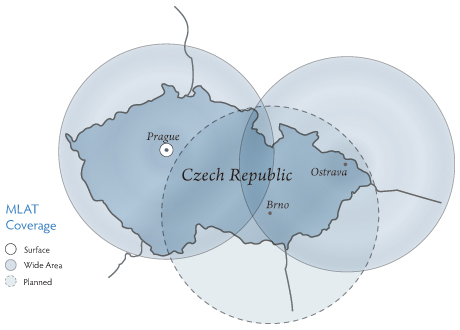| Ivan Uhlir is confident that within five to seven years, multilateration systems will reach equality in surveillance versus traditional SSRs, and will exceed them in perhaps 10 to 12 years. Plans are already underway at the ANS to decommission one SSR in the center of the country within the next two or three years as a result of linking the Ostrava and Prague multilateration systems. However, the Czech ANS is also looking beyond its borders for two reasons. First, multilateration lends itself perfectly to trans-border system sharing by supporting the seamless surveillance of air traffic between neighboring states. Second, with its extensive experience in the application, planning, installation and certification of multilateration systems, the ANS is one of the foremost multilateration authorities in the world and is ready to offer that expertise to other ANSPs. Jan Klas, the new Director General of the ANS, is anxious to move ahead on these two fronts. “I see great potential for multilateration in both areas,” he says, “and I know there are many signs of interest from other ANSPs.” Plans are being developed for a new multilateration network centered on Brno in Czech Moravia, which lies along the Austrian border to the south. The Brno system is especially necessary, because Austrocontrol intends to decommission its SSR at Buschberg, near Vienna, that currently provides low level surveillance over the south of the Czech Republic. “This technology,” says Jan Klas, “is very supportive of the single sky concept, which is particularly important in Central Europe, where the airspace is very fragmented.” Looking further ahead, he feels that there are important operational and cost advantages to be gained from cross border cooperation. “I believe it would be very good to share the costs, the service and the logistics support, which could be from regional service centers, rather than being restricted to within each nations’ borders.” But Jan Klas’s vision goes beyond his country’s immediate borders, and recognizes that Czech ANS expertise can be applied wherever it could be needed. “There are windows of opportunities in the future where we can promote this technology, not only as a user, but potentially as a partner to industry.” Much has happened with multilateration since those early days in 1998, when Czech engineers set out to evaluate the possible development and application of a former military detection system to the equally exacting challenge of civil aircraft surveillance. From simple tests ten years ago in a small park outside Prague, the system has swept through the whole spectrum of air traffic management applications, winning ready acceptance around the world. Yet in the words of one Czech ANS engineer, “Over the past ten years, we have probably only begun to realize multilateration’s full potential.” | | 
|

